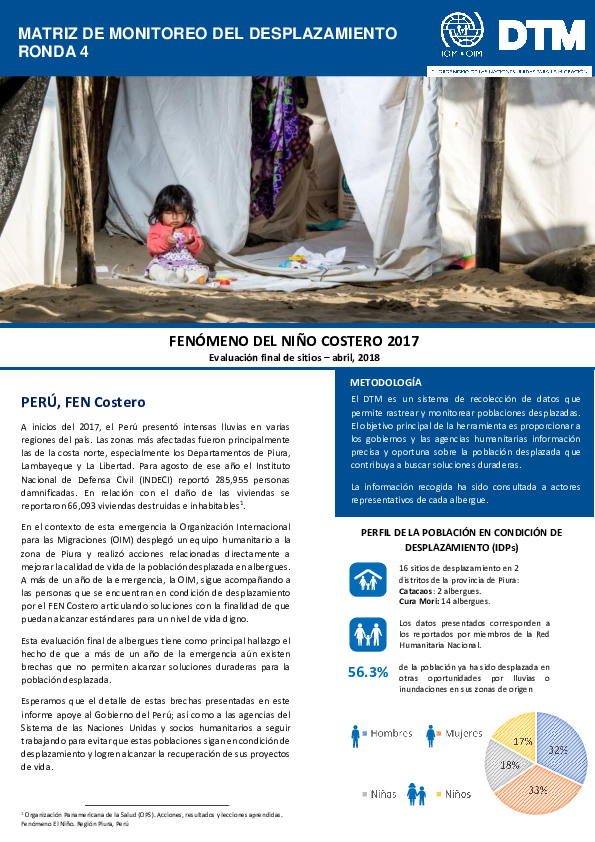-
Countries
-
Data and Analysis
-
Special Focus
-
Crisis Responses
Peru
Suivi des PDI
Mouvements de déplacement
75,000
IDMC 2023
cycle de collecte de données
À propos Peru
The Displacement Tracking Matrix (DTM) is a modular system that IOM uses to capture, process and disseminate information on the different phases of human mobility, routes and places of displacement, the degree of vulnerability and the main needs of protection of these populations around the world.
The El Niño coastal phenomenon, triggered by the increase in the surface temperature of the sea, caused continuous rainfall in Peru through February and March 2017. This increased rainfall led to severe flooding in rural communities and urban areas in 24 of the country’s 25 departments. Approximately 1.1 million people were affected in total. One third of the affected population was identified in the department of Piura. The flooding had a significant impact on the livelihoods of the affected population and caused significant internal displacement. DTM operations conducted three rounds of Mobility Tracking from April to September 2017.
Flow monitoring of Venezuelan population flows are ongoing since October 2017. The flow monitoring operations are conducted in collaboration with UNICEF and funded by UN CERF and USAID. The flow monitoring points are situated on the northern and southern borders of Peru, as well as important influx points such as in Metropolitan Lima.
Contacter
IOM Peru
iomperudtm@iom.int
Bailleurs de fonds
- CERF
- IOM
- PRM
Perú — Flujo de Migración Venezolana, Ronda 3 (Abril - Mayo 2018)
La OIM Perú ha implementado la DTM sobre “Monitoreo de flujo de migración venezolana” en tres rondas. La Ronda 3 se aplicó en en las fronteras norte y sur del país y en puntos de afluencia en Lima Metropolitana entre abril y mayo del 2018.
Peru — Migration Flows from Venezuela, Round 2 (December 2017— January 2018)
DTM Peru has implemented two rounds on "Monitoring Venezuelan Migration Flows." Round 2 (R2), the subject of this report, was applied in the cities of Tumbes, Tacna and Metropolitan Lima between December 2017 and January 2018.
Perú — Piura, Ronda 4 Evaluación de Sitios (Abril 2018)
A inicios de 2017 en el Perú, el fenómeno del Niño Costero ha causado lluvias, huaicos e inundaciones, dejando a 285,955 personas damnificadas. Las regiones más afectadas han sido Piura, Lambayeque y La Libertad, al norte del país.
Perú — Flujo de Migración Venezolana, Ronda 2 (Diciembre 2017 — Enero 2018)
La OIM Perú ha implementado la DTM sobre “Monitoreo de flujo de migración venezolana” en dos rondas.
Perú — Flujo de Migración Venezolana, Infographics Round 2 (February 2018)
The following infographics provide an overview of the information obtained through data collection in Round 2 on the migration flows from Venezuela. Economic reasons are the main driver for displacement from Venezuela and 73% of the assessed individuals are under 35 years old.
Perú — Flujo de Migración Venezolana, Ronda 2, Infografías (Febrero 2018)
The following infographics provide an overview of the information obtained through data collection in Round 2 on the migration flows from Venezuel0a, focusing on the following four thematic areas: Protection, living conditions, migratory route, labour information and public services.
Perú — Flujo de Migración Venezolana, Ronda 1 (octubre — noviembre 2017)
Actualmente se estima que más de 1 millón de venezolanos se encuentran en el exterior. En la región sudamericana la migración se ha dado especialmente a los países de Argentina, Brasil, Chile, Colombia, Ecuador y Perú.
Perú — Piura, Ronda 3 Evaluación de Sitios (septiembre 2017)
A inicios de 2017 en el Perú, el fenómeno del Niño Costero ha causado lluvias, huaicos e inundaciones, dejando a 283 mil personas damnificadas. Las regiones más afectadas han sido Piura, Lambayeque y La Libertad, al norte del país.
Perú – Piura y Lambayeque, Evaluación de Sitios, Ronda 2 (23 Mayo 2017)
A la fecha, la cifra de la población afectada y damnificada ha superado el 1.3 millones de personas.
Perú – Lima, Ronda 1 Perfil de Sitio (15 Abril 2017)
El fenómeno “El Niño Costero” que se generó por el incremento de la temperatura superficial del mar, causo precipitaciones continuas en los meses de febrero y marzo, afectando particularmente la costa norte de Perú. Se declaro un esdato de emergencia en 12 departamentos
Perú – Piura, Ronda 1 Perfil de Sitio (15 Abril 2017)
El fenómeno “El Niño Costero” que se generó por el incremento de la temperatura superficial del mar, causo precipitaciones continuas en los meses de febrero y marzo, afectando particularmente la costa norte de Perú. Se declaro un esdato de emergencia en 12 departamentos y una
Pagination
- First page
- Previous page
- 1
- 2
- 3
- 4
- 5















